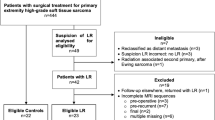Abstract
Objectives
To assess the prevalence of the tail sign in soft tissue sarcomas and determine whether the local recurrence rate differed based on the presence of the tail sign.
Methods
In our retrospective study, myxofibrosarcoma (MFS, n = 25) and undifferentiated sarcoma (US, n = 38) comprised group 1, and the remaining tumours (n = 115) were assigned to group 2. Location, size, and imaging features of the tumours were assessed on MRI. The radiological-pathological correlation of the tail sign was analysed.
Results
The tail sign, thick fascial enhancement extending from the tumour margin, was more common and significantly thicker in group 1. In the subgroup analysis between MFS and US, there was no significant difference in the presence of a tail sign. Histological examination revealed extensive tumour cell infiltrations along the deep fascia from the main mass. Patients with a tail sign had a worse local recurrence-free survival than patients without it, not only in all tumours (p < 0.01), but also in group 1 (p = 0.019)
Conclusions
The tail sign was a common MRI feature of both MFS and US, and was also associated with worse local recurrence-free survival. Radiologists should be aware of these MRI findings and inform the surgeon preoperatively in order to obtain a sufficient surgical margin to minimise the risk of local tumour recurrence.
Key Points
• The tail sign was a common MRI feature of myxofibrosarcoma and undifferentiated sarcoma.
• The tail sign may be associated with worse local recurrence-free survival
• Radiologists should be aware of this MRI finding and inform the surgeon






Similar content being viewed by others
Abbreviations
- MFH:
-
Malignant fibrous histiocytoma
- MFS:
-
Myxofibrosarcoma
- US:
-
Undifferentiated sarcoma
- MRI:
-
Magnetic resonance imaging
- LRFS:
-
Local recurrence-free survival
References
Enjoji M, Hashimoto H, Tsuneyoshi M, Iwasaki H (1980) Malignant fibrous histiocytoma. A clinicopathologic study of 130 cases. Acta Pathol Jpn 30:727–741
Fletcher CD, Gustafson P, Rydholm A, Willen H, Akerman M (2001) Clinicopathologic re-evaluation of 100 malignant fibrous histiocytomas: prognostic relevance of subclassification. J Clin Oncol 19:3045–3050
Gibbs JF, Huang PP, Lee RJ et al (2001) Malignant fibrous histiocytoma: an institutional review. Cancer Investig 19:23–27
Fletcher CD (2006) The evolving classification of soft tissue tumours: an update based on the new WHO classification. Histopathology 48:3–12
Rosenberg AE (2013) WHO classification of soft tissue and bone, fourth edition: summary and commentary. Curr Opin Oncol 25:571–573
Petersen I (2013) The new WHO classification and recent results in soft tissue tumor pathology. Pathologe 34:436–448
Fanburg-Smith JC, Spiro IJ, Katapuram SV, Mankin HJ, Rosenberg AE (1999) Infiltrative subcutaneous malignant fibrous histiocytoma: a comparative study with deep malignant fibrous histiocytoma and an observation of biologic behavior. Ann Diagn Pathol 3:1–10
Huang HY, Lal P, Qin J, Brennan MF, Antonescu CR (2004) Low-grade myxofibrosarcoma: a clinicopathologic analysis of 49 cases treated at a single institution with simultaneous assessment of the efficacy of 3-tier and 4-tier grading systems. Hum Pathol 35:612–621
Kaya M, Wada T, Nagoya S et al (2008) MRI and histological evaluation of the infiltrative growth pattern of myxofibrosarcoma. Skeletal Radiol 37:1085–1090
Lefkowitz RA, Landa J, Hwang S et al (2013) Myxofibrosarcoma: prevalence and diagnostic value of the "tail sign" on magnetic resonance imaging. Skeletal Radiol 42:809–818
Mentzel T, Calonje E, Wadden C et al (1996) Myxofibrosarcoma. Clinicopathologic analysis of 75 cases with emphasis on the low-grade variant. Am J Surg Pathol 20:391–405
Wada T, Hasegawa T, Nagoya S, Kawaguchi S, Kaya M, Ishii S (2000) Myxofibrosarcoma with an infiltrative growth pattern: a case report. Jpn J Clin Oncol 30:458–462
Weiss SW, Enzinger FM (1978) Malignant fibrous histiocytoma: an analysis of 200 cases. Cancer 41:2250–2266
Waters B, Panicek DM, Lefkowitz RA et al (2007) Low-grade myxofibrosarcoma: CT and MRI patterns in recurrent disease. AJR Am J Roentgenol 188:W193–W198
Weiss SW, Enzinger FM (1977) Myxoid variant of malignant fibrous histiocytoma. Cancer 39:1672–1685
Merck C, Angervall L, Kindblom LG, Oden A (1983) Myxofibrosarcoma. A malignant soft tissue tumor of fibroblastic-histiocytic origin. A clinicopathologic and prognostic study of 110 cases using multivariate analysis. Acta Pathol Microbiol Immunol Scand Suppl 282:1–40
Matsumoto S, Ahmed AR, Kawaguchi N, Manabe J, Matsushita Y (2003) Results of surgery for malignant fibrous histiocytomas of soft tissue. Int J Clin Oncol 8:104–109
Acknowledgements
The scientific guarantor of this publication is Sung Hwan Hong,1M.D., Ph.D. The authors of this manuscript declare no relationships with any companies whose products or services may be related to the subject matter of the article. The authors state that this work has not received any funding. No complex statistical methods were necessary for this article. Institutional Review Board approval was obtained. Written informed consent was waived by the Institutional Review Board. Methodology: retrospective, observational, performed at one institution.
Author information
Authors and Affiliations
Corresponding author
Rights and permissions
About this article
Cite this article
Yoo, H.J., Hong, S.H., Kang, Y. et al. MR imaging of myxofibrosarcoma and undifferentiated sarcoma with emphasis on tail sign; diagnostic and prognostic value. Eur Radiol 24, 1749–1757 (2014). https://doi.org/10.1007/s00330-014-3181-2
Received:
Revised:
Accepted:
Published:
Issue Date:
DOI: https://doi.org/10.1007/s00330-014-3181-2




